Susan Strom
EF5
03/11/06 REPORTS - Arizona Desert - Massive Winter Storm
Arizona Desert - Massive Winter Storm
"The Moods of a Mysterious Mountain"
Superstition Range, March 11, 2006
Apache Junction, Arizona
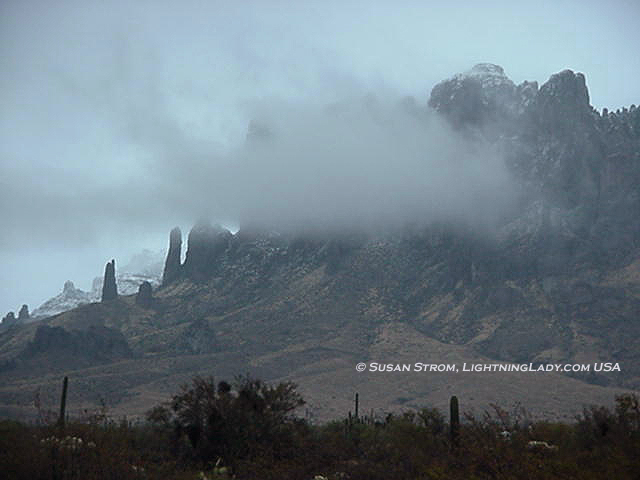
The day that one understands the soul of the desert, it becomes clear that the desert is not about heat, but extremes.
"Blue is the color of the red mountain" is a phrase I often say to myself when driving. Today the mountain is white. Tomorrow purple. Next week the cliffs will be green. Nothing in the desert stays the same for long. Despite the outward appearance to many a visitor's untrained eye, the arid landscape is fluid of change and bursting with life. The only condition of desert life is that it must be evolved to the point of such elegance and precision that it can survive all that the desert hands down. The desert is the ultimate system of zero defects. Any flaws have long been weeded out.
This desert has been patient, as rain has not been seen in Phoenix since the Hunter's Moon. The last measurable precip occurred over 140 days ago, during October. Now, on March 11, the unusual dry streak has not only now been broken, but shattered. The finish line came today in the form of horizontally blowing whiteout in Prescott, Arizona, major highway closures near Phoenix, and blankets of the white stuff all over Scottsdale, a palm-tree studded town famous for chamber of commerce weather.
On my first attempt to snow-chase a northerly route this afternoon, I was headed off at the pass. My plan was to try Highway 87 to Payson, to see the snow drifts blanketing v-shaped canyons in the Mazatzal Range. At the Fort McDowell Indian Community northeast of Phoenix, I learned that Highway 87 had already been closed. Plan B was to head out to a frequent eastern chase-place, the Superstition Range, but I was concerned about delays in Mesa, notorious for street flooding and power outages I often contend with during summer monsoon. However, the prospect of the Superstitions having a mood swing was too strong a lure. I didn't know what I would find, thus, the fun begins.
Passing through puddle after puddle in heavy rain on a two-lane road due east to Hwy 88, the Apache Trail, the Superstition Mountain came within view but became almost invisible, shrouded in thick white clouds. I felt a twinge of disappointment, but it didn't last. Slowly as I got closer, the bridal veil cloak was lifted and I could see the jutting spires...plus...the ridges were covered in snow!! It looked nothing like it does during monsoon. White is the color of the red mountain.
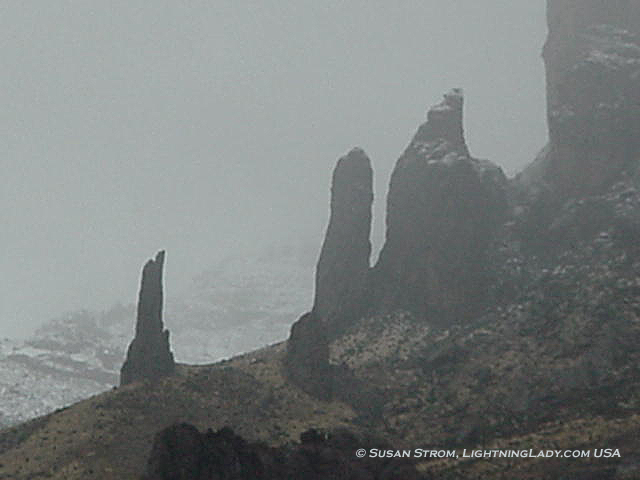
Tonight at the Mammoth Saloon (founded 1893 at Goldfield), where I often stop for coffee (and wild-west vantage points) after I chase out that way, the silver-haired owner stated, "I haven't seen snow on that mountain in over 5 years." I sipped my coffee and thawed out from being freezing and soaked to the skin. The power kept flickering overhead and a gentleman with a handlebar mustache said it might go out for the third time today.
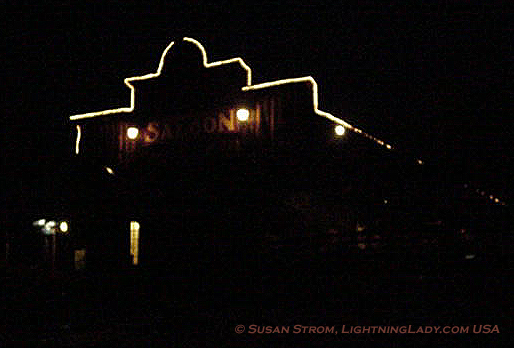
The 160,000-acre behemoth Superstition Range is actually one of the world's most mysterious places. Local lore tells of over 70 persons, each individually looking for a fortune, who entered the range and never returned. In 1891, Jacob Waltz, known as "The Dutchman", supposedly took the location of a rich gold cache to his grave. Some say it is lying in the shadow of Weaver's Needle, a jutting spire visible from some points in the range. Others say the stash doesn't exist at all, or that the fortune in gold was brought there from somewhere else and within the mountain it remains.
The intensity of the changing rocks is only enhanced by weather features, like summer thunderstorms that occur over the jagged flatirons, filling the sky with electric cowboy rope. See that example here (2004):
http://www.lightninglady.com/photos/StromDutch.jpg
Today, on the 11th of March, I am not prospecting for the Lost Dutchman's gold but for a white mountain with a cold stare.
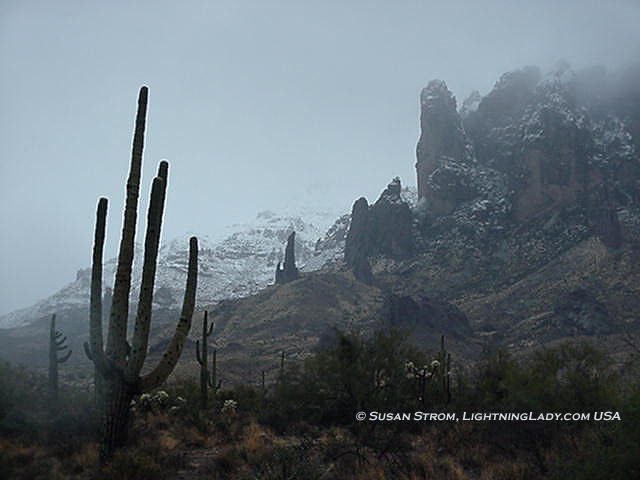
Sometimes, when the sun is at a certain low angle, rather than a scene like today's, I find an intensely fiery red mountain akin to a Martian landscape. Each blast of 110-degree desert wind gives me gooseflesh and reminds me of the zero defects law.
http://www.lightninglady.com/photos/StromLostDutch.jpg
Therefore, like any good desert critter, I always travel with the means to protect myself - a surplus of water, food, all necessary supplies and a car in good repair.
I have learned to embrace and enjoy the moods of the mysterious mountain and the only thing it guarantees me, the unexpected. Just for today, the red/green/purple/blue mountain is snowy white.
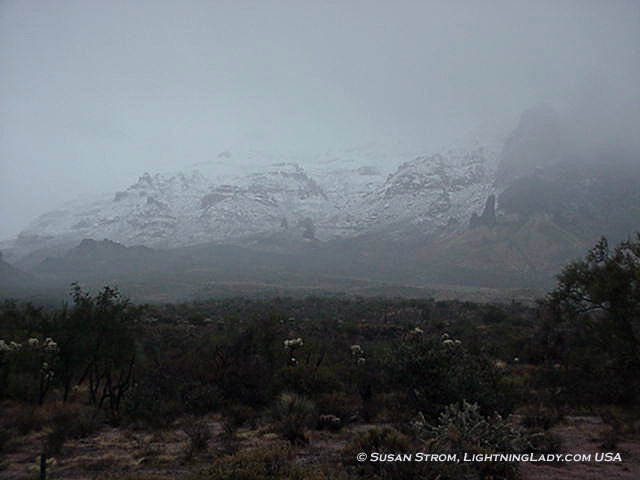
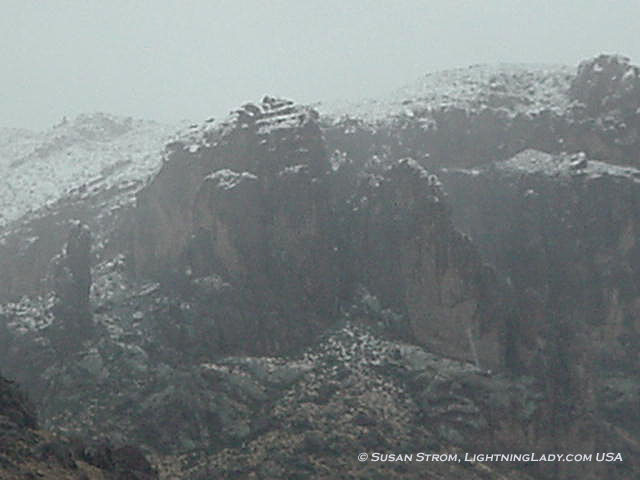
Superstition Mountain and Wilderness vital stats
Location: This mountain feature is located 5 miles north of Apache Junction, off AZ 88 (the old Apache Trail).
Terrain: Desert, vertical cliffs, crags and flatirons.
Temps (daytime): Winter: 60s Summer: 100+
Nearby feature: Goldfield ghost town
Lore: As the story goes, the Peralta family of Mexico developed a gold mine in the Superstitions in the 1840s.
The family's last expedition was said to have been ambushed by Apaches, but the gold remained. Around 1870, Jacob Waltz (called "the Dutchman") was believed to have found the mine through a tip from a Peralta descendant. Apparently he and another gentleman Jacob Weiser, worked the mine and hid the cache(s) of gold at places somewhere in the mountains. Most lore points to Weaver's Needle ("in the shadow of Weaver's Needle") as the approximate location of the "Lost Dutchman's gold".

Snow on Weaver's Needle...Sunday 3/12/06
Superstition Wilderness: 159,780 acres/242 square miles of rugged desert mountainous terrain. Mountain peaks ascend to 6,000 feet. Deep cut v-shaped canyons traverse the wilderness area. Superstition Mountain, which is part of Superstition Wilderness, ascends vertically to 3,000 feet above the desert floor. To me, from the south side (not visible here) the monolithic mountain looks like a Titanic-style ship in a desert sea.
Plants: Sonoran such as Giant Saguaro, ocotillo, cholla, prickly pear, palo verde tree. This area is known also for spectacular wildflower blooms.
Animals: Mountain lion, bear, coyote, bobcat, javalina (like wild boar), quail, rattlesnake, scorpion, and the occasional storm chaser.
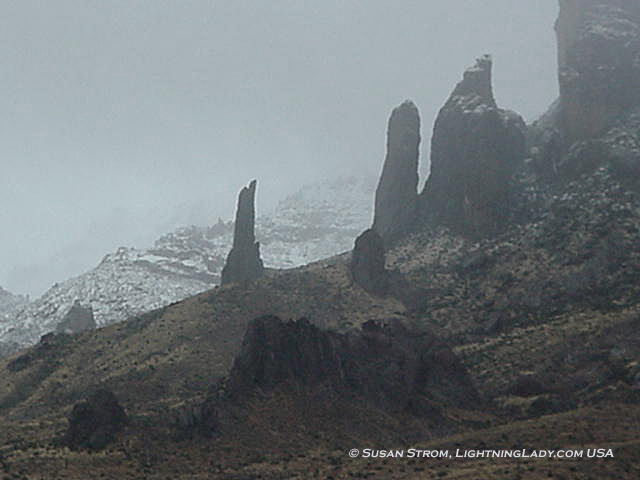
Arizona Desert - Massive Winter Storm
"The Moods of a Mysterious Mountain"
Superstition Range, March 11, 2006
Apache Junction, Arizona

The day that one understands the soul of the desert, it becomes clear that the desert is not about heat, but extremes.
"Blue is the color of the red mountain" is a phrase I often say to myself when driving. Today the mountain is white. Tomorrow purple. Next week the cliffs will be green. Nothing in the desert stays the same for long. Despite the outward appearance to many a visitor's untrained eye, the arid landscape is fluid of change and bursting with life. The only condition of desert life is that it must be evolved to the point of such elegance and precision that it can survive all that the desert hands down. The desert is the ultimate system of zero defects. Any flaws have long been weeded out.
This desert has been patient, as rain has not been seen in Phoenix since the Hunter's Moon. The last measurable precip occurred over 140 days ago, during October. Now, on March 11, the unusual dry streak has not only now been broken, but shattered. The finish line came today in the form of horizontally blowing whiteout in Prescott, Arizona, major highway closures near Phoenix, and blankets of the white stuff all over Scottsdale, a palm-tree studded town famous for chamber of commerce weather.
On my first attempt to snow-chase a northerly route this afternoon, I was headed off at the pass. My plan was to try Highway 87 to Payson, to see the snow drifts blanketing v-shaped canyons in the Mazatzal Range. At the Fort McDowell Indian Community northeast of Phoenix, I learned that Highway 87 had already been closed. Plan B was to head out to a frequent eastern chase-place, the Superstition Range, but I was concerned about delays in Mesa, notorious for street flooding and power outages I often contend with during summer monsoon. However, the prospect of the Superstitions having a mood swing was too strong a lure. I didn't know what I would find, thus, the fun begins.
Passing through puddle after puddle in heavy rain on a two-lane road due east to Hwy 88, the Apache Trail, the Superstition Mountain came within view but became almost invisible, shrouded in thick white clouds. I felt a twinge of disappointment, but it didn't last. Slowly as I got closer, the bridal veil cloak was lifted and I could see the jutting spires...plus...the ridges were covered in snow!! It looked nothing like it does during monsoon. White is the color of the red mountain.

Tonight at the Mammoth Saloon (founded 1893 at Goldfield), where I often stop for coffee (and wild-west vantage points) after I chase out that way, the silver-haired owner stated, "I haven't seen snow on that mountain in over 5 years." I sipped my coffee and thawed out from being freezing and soaked to the skin. The power kept flickering overhead and a gentleman with a handlebar mustache said it might go out for the third time today.

The 160,000-acre behemoth Superstition Range is actually one of the world's most mysterious places. Local lore tells of over 70 persons, each individually looking for a fortune, who entered the range and never returned. In 1891, Jacob Waltz, known as "The Dutchman", supposedly took the location of a rich gold cache to his grave. Some say it is lying in the shadow of Weaver's Needle, a jutting spire visible from some points in the range. Others say the stash doesn't exist at all, or that the fortune in gold was brought there from somewhere else and within the mountain it remains.
The intensity of the changing rocks is only enhanced by weather features, like summer thunderstorms that occur over the jagged flatirons, filling the sky with electric cowboy rope. See that example here (2004):
http://www.lightninglady.com/photos/StromDutch.jpg
Today, on the 11th of March, I am not prospecting for the Lost Dutchman's gold but for a white mountain with a cold stare.

Sometimes, when the sun is at a certain low angle, rather than a scene like today's, I find an intensely fiery red mountain akin to a Martian landscape. Each blast of 110-degree desert wind gives me gooseflesh and reminds me of the zero defects law.
http://www.lightninglady.com/photos/StromLostDutch.jpg
Therefore, like any good desert critter, I always travel with the means to protect myself - a surplus of water, food, all necessary supplies and a car in good repair.
I have learned to embrace and enjoy the moods of the mysterious mountain and the only thing it guarantees me, the unexpected. Just for today, the red/green/purple/blue mountain is snowy white.


Superstition Mountain and Wilderness vital stats
Location: This mountain feature is located 5 miles north of Apache Junction, off AZ 88 (the old Apache Trail).
Terrain: Desert, vertical cliffs, crags and flatirons.
Temps (daytime): Winter: 60s Summer: 100+
Nearby feature: Goldfield ghost town
Lore: As the story goes, the Peralta family of Mexico developed a gold mine in the Superstitions in the 1840s.
The family's last expedition was said to have been ambushed by Apaches, but the gold remained. Around 1870, Jacob Waltz (called "the Dutchman") was believed to have found the mine through a tip from a Peralta descendant. Apparently he and another gentleman Jacob Weiser, worked the mine and hid the cache(s) of gold at places somewhere in the mountains. Most lore points to Weaver's Needle ("in the shadow of Weaver's Needle") as the approximate location of the "Lost Dutchman's gold".

Snow on Weaver's Needle...Sunday 3/12/06
Superstition Wilderness: 159,780 acres/242 square miles of rugged desert mountainous terrain. Mountain peaks ascend to 6,000 feet. Deep cut v-shaped canyons traverse the wilderness area. Superstition Mountain, which is part of Superstition Wilderness, ascends vertically to 3,000 feet above the desert floor. To me, from the south side (not visible here) the monolithic mountain looks like a Titanic-style ship in a desert sea.
Plants: Sonoran such as Giant Saguaro, ocotillo, cholla, prickly pear, palo verde tree. This area is known also for spectacular wildflower blooms.
Animals: Mountain lion, bear, coyote, bobcat, javalina (like wild boar), quail, rattlesnake, scorpion, and the occasional storm chaser.

